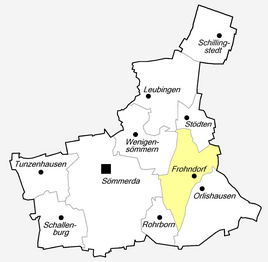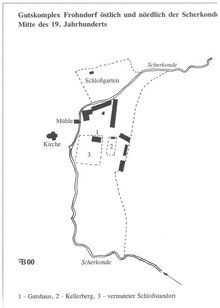Frohndorf
|
Frohndorf
City of Sömmerda
Coordinates: 51 ° 9 ′ 46 ″ N , 11 ° 11 ′ 12 ″ E
|
|
|---|---|
| Height : | 140 m above sea level NN |
| Residents : | 457 (2010) |
| Incorporation : | March 8, 1994 |
| Postal code : | 99610 |
| Area code : | 03634 |
|
Location of Frohndorf in Sömmerda
|
|
Frohndorf is a district of the town of Sömmerda in the Thuringian district of Sömmerda . The place was incorporated into a district town in 1994.
geography
Frohndorf lies east of the actual town of Sömmerda and is traversed by the Scherkonde . The district is located in the Thuringian Basin not far from the Unstrut lowlands .
history
The first documented mention dates from May 18, 876.
The place, in which the ministerial family von Vrondorf was resident, belonged since 1221 to the domain of the Counts of Beichlingen , who in turn were feudal bearers of the Landgraves of Thuringia. In 1448, Duke Wilhelm of Saxony, as feudal lord, gave his consent to the pledging of parts of the former county of Beichlingen by the heavily indebted Counts Günther and Hans von Beichlingen to their related Counts Botho zu Stolberg and Heinrich von Schwarzburg . These included the castles and villages: Frohsdorf, wholesale and Wenigenorlishausen , large - and Kleinneuhausen , Ellersleben , Bachra , Backleben , Rettgenstedt , Battgendorf , Dermsdorf , Schillingstedt , Altenbeichlingen , Hemleben and Hauteroda . In addition, the annual income from the city of Kölleda was pledged. After the death of Count Günther von Beichlingen in 1454, the Stolberg and Schwarzburg counts acquired this pledge for 22,550 Rhenish guilders. This resulted in the Schwarzburg-Stolberg rule of Frohndorf, which included part of the former county of Beichlingen. In contrast to the deposit from 1448, the villages of Altenbeichlingen, Hemleben and Hauteroda, which remained with the Counts of Beichlingen, were missing.
In 1468, Count Heinrich von Schwarzburg sold his share of the Frohndorf estate to Count Heinrich zu Stolberg. As early as 1480, Anton von Werthern's councilor from Stolberg, represented a family that was to determine the rule of Frohndorf in the later years. At that time, Werthern was awarded several goods in Frohndorf for his services as a Stolberg councilor. Due to debts, the Stolberg Counts Frohndorf sold to the knight and Weißenfels bailiff Hans von Werthern in 1505 . Only after 25 years Ch could. Werthern of the castle build modern Renaissance-style for that time. There were u a. a mansion, writing room, court room, bath room. Half of the castle was also inhabited by the Lords of Wiehe. Later there was a pleasure garden, kitchen garden, courtyard garden and tree gardens next to the farm yard. The gatehouse was built. So the house developed into a palace and the courtyard into an estate. It must have been an important building, as Frohndorf was the master palace of a branch of the von Werthern family and eight to eleven other villages belonged to the Frohndorf estate.
In 1776, Goethe paid a visit to Frohndorf Castle. From 1789 to 1804 Cäcilie von Werthern (born von Ziegesar, from Drackendorf) lived in Frohndorf. Her husband, Christian Georg Freiherr von Werthern, had most of the palace demolished in the 1790s and wanted a new building to be built by the court architect Johann Friedrich Rudolf Steiner . A representative three-wing complex with two round towers was planned within the moat . After the death of Herr von Werthern in 1800, the plans, which had already come a long way, were not pursued any further. They contented themselves with building a large manor house , which is still standing today. The moats were filled. The preserved "Kellerberg" in the estate is probably the rest of an old "cellar house".
Until 1815, Frohndorf belonged to the Electoral Saxon office of Eckartsberga . The decisions of the Congress of Vienna the place to Prussia came only in 1816 the district Eckartsberga in the administrative district of Merseburg of the Province of Saxony assigned to which he belonged until 1944th After the Second World War , in the course of the land reform in the Soviet Zone, the land and the manor buildings including their inventory were expropriated without compensation.
In 1855 a Neolithic collective grave was removed from the Sperberhügel . The complex, laid out with stone slabs, was provided with human skeletal remains, tooth jewelry and other finds. Subsequent burials indicate the importance of this site.
Attractions
Population numbers
Development of the population:
|
Personalities
- August Wilhelm Ernesti (1733–1801), classical philologist
literature
- Frank Boblenz : The joy of high priestess - Cäcilie von Werthern (1773-1831), Karl August von Böttiger (1760-1835) and Frohndorf. In: Sömmerdaer Heimatheft. H. 14, 2002, ZDB -ID 1158652-7 , pp. 60-92.
Individual evidence
- ^ Wolfgang Kahl : First mention of Thuringian towns and villages. A manual. 5th, improved and considerably enlarged edition. Rockstuhl, Bad Langensalza 2010, ISBN 978-3-86777-202-0 , p. 24.
- ↑ Jörg Brückner : Between imperial estate and state rule. The Counts of Stolberg and their relationship to the Landgraves of Thuringia and later dukes, electors and kings of Saxony (1210 to 1815) (= publications of the Landesheimatbund Sachsen-Anhalt eV on state, regional and local history . Volume 2 ). Stekovics, Dößel 2005, ISBN 3-89923-119-8 (also: Chemnitz, Technical University, dissertation, 2003).
- ↑ Places of the Prussian district Eckartsberga in the municipality register 1900
- ↑ Frank Boblenz: From the "courtyard" to the castle - the history of Frohndorf Castle. In: Heiko Laß (Hrsg.): From the castle to the castle. Sovereign and aristocratic secular building in Thuringia in the 15th and 16th centuries (= palm tree texts. 10). quartus-Verlag, Bucha bei Jena 2001, ISBN 3-931505-80-4 , pp. 193-214.
- ↑ Michael Köhler: Pagan sanctuaries. Pre-Christian places of worship and suspected cult sites in Thuringia. Jenzig-Verlag Köhler, Jena 2007, ISBN 978-3-910141-85-8 , p. 335.




